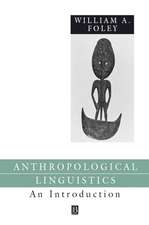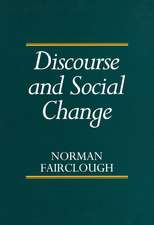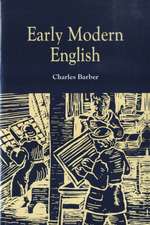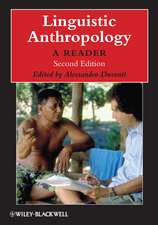An Introduction to Interaction: Understanding Talk in Formal and Informal Settings
Autor Associate Professor Angela Cora Garciaen Limba Engleză Paperback – 9 oct 2013
| Toate formatele și edițiile | Preț | Express |
|---|---|---|
| Paperback (2) | 193.62 lei 3-5 săpt. | +60.76 lei 5-11 zile |
| Bloomsbury Publishing – 17 mai 2023 | 193.62 lei 3-5 săpt. | +60.76 lei 5-11 zile |
| Bloomsbury Publishing – 9 oct 2013 | 264.64 lei 6-8 săpt. | +71.75 lei 5-11 zile |
| Hardback (2) | 551.17 lei 6-8 săpt. | +125.76 lei 5-11 zile |
| Bloomsbury Publishing – 17 mai 2023 | 551.17 lei 6-8 săpt. | +125.76 lei 5-11 zile |
| Bloomsbury Publishing – 9 oct 2013 | 1014.15 lei 6-8 săpt. |
Preț: 264.64 lei
Nou
Puncte Express: 397
Preț estimativ în valută:
50.64€ • 53.00$ • 42.15£
50.64€ • 53.00$ • 42.15£
Carte tipărită la comandă
Livrare economică 31 martie-14 aprilie
Livrare express 22-28 februarie pentru 81.74 lei
Preluare comenzi: 021 569.72.76
Specificații
ISBN-13: 9781441157614
ISBN-10: 1441157611
Pagini: 368
Dimensiuni: 189 x 246 x 20 mm
Greutate: 0.72 kg
Editura: Bloomsbury Publishing
Colecția Bloomsbury Academic
Locul publicării:London, United Kingdom
ISBN-10: 1441157611
Pagini: 368
Dimensiuni: 189 x 246 x 20 mm
Greutate: 0.72 kg
Editura: Bloomsbury Publishing
Colecția Bloomsbury Academic
Locul publicării:London, United Kingdom
Caracteristici
Lecturer's Handbook provides quiz and essay questions, additional data excerpts, audio and exercises.
Notă biografică
Angela Cora Garcia is Associate Professor of Sociology at Bentley University, USA.
Cuprins
Part 1: Theory, Method and Data for Conversation AnalysisChapter 1: Introduction to the Study of Conversation AnalysisChapter 2: Understanding Ethnomethodology Chapter 3: Understanding and Doing Conversation Analysis: Methodological Approach Chapter 4: Preparing the Data:Transcription Practices Part 2: How Talk Works:The Social Organization of Human ActionChapter 5: The Turn-Taking System Chapter 6: Adjacency Pairs, Preference Organization, and Assessments Chapter 7: Sequential Organization:Interrogative Series, Insertion Sequences, Side Sequences, and Pre-SequencesChapter 8: Openings Chapter 9: Closings Chapter 10: Error Avoidance and Repair Chapter 11: Creating Topical CoherenceChapter 12: Story Telling and the Embodied Nature of Face to Face Interaction Chapter 13: Referring to PersonsPart 3: Technologically Mediated Interaction:Work Done Through and with TechnologyChapter 14: Routine Service Calls:Emergency Calls to the PoliceChapter 15: Problematic Emergency Service CallsChapter 16: Technological Transformations and Talk on the TelephoneChapter 17: Air Traffic Communication Part 4: Talk in Medical SettingsChapter 18: Doctor Patient Communication and the Delivery of Bad NewsChapter 19: The Primary Care Consultation:Diagnostic Interviews and Medical AdvicePart 5: Talk in Legal SettingsChapter 20: Trials and Other Public Legal ProceedingsChapter 21: Behind the Scene Interrogations in Institutional ContextChapter 22: Talk in Mediation SessionsPart 6: Talk in Broadcast MediaChapter 23: Television News InterviewsChapter 24: Call-in Talk Shows on Radio and Television Part 7: Talk in Business SettingsChapter 25: Talk in Business Contexts:Doing Customer ServiceChapter 26: Talk in Business Contexts:Meetings, Interviews, and Performance Appraisals Chapter 27: Conclusions ReferencesIndex
Recenzii
[A]n important textbook that engages closely with theoretical and practical aspects of CA. The book is very 'user-friendly' and approaches its subject matter from a straightforward and common sense point of view. No doubt, this book will be of interest to students of sociology, linguistics and communication studies.
[A] comprehensive guide for (mainly, but not only) linguistics, sociology, communication and even business students ... [The book] could be used autonomously by students ... [as well as] in class ... Each of the chapters is written in an understandable way using a clear and simple style.
This comprehensive yet-easy-to-read guide will be a boon to any student struggling with the concepts and methods of Conversation Analysis. The coverage is admirably wide without sacrificing depth - a must-have for the student and teacher of language in interaction.
I am very favorably impressed with this volume. The book is organized well. It addresses a wide variety of contexts, and the writing is clear and cogent. Prof. Garcia has a masterful command of the conversation analysis (CA) literature, and it shows in the writing. I would definitely use this in my classes on ethnomethodology, language and social interaction, and organizational discourse analysis. Without question, I believe that this volume will enable beginning students and scholars to learn how to do CA and develop an initial understanding of the theoretical commitments associated with ethnomethodology. I predict that this volume will be widely embraced by the CA community, if not the discourse community more generally. It is absolutely first rate.
Angela Cora Garcia has succeeded in producing an absorbing, comprehensive and accessible introduction to conversation analysis.This lively textbook presents the principles and techniques of studying real spoken interaction using an array of examples from casual conversation to business meetings and covering a range of languages including Spanish, Japanese, Chinese and French.Key issues and theories are clearly presented and there are questions and tasks which encourage readers to collect and analyze spoken data for themselves. The book will be extremely useful to students in a range of undergraduate courses dealing with spoken discourse.
A fine introduction to Conversation Analysis, its theoretical underpinnings and its methodology with particular value for those studying various work settings, communication, and everyday interaction.
This is the best possible introduction to conversation analysis. With its elaborate terminology, CA can be intimidating to the uninitiated. However, this Intro to CA - with all of its examples, activities, super clear explanations of major concepts, and its overall organization - is everything a textbook should be. I can't wait to use it with my students!
[A] comprehensive guide for (mainly, but not only) linguistics, sociology, communication and even business students ... [The book] could be used autonomously by students ... [as well as] in class ... Each of the chapters is written in an understandable way using a clear and simple style.
This comprehensive yet-easy-to-read guide will be a boon to any student struggling with the concepts and methods of Conversation Analysis. The coverage is admirably wide without sacrificing depth - a must-have for the student and teacher of language in interaction.
I am very favorably impressed with this volume. The book is organized well. It addresses a wide variety of contexts, and the writing is clear and cogent. Prof. Garcia has a masterful command of the conversation analysis (CA) literature, and it shows in the writing. I would definitely use this in my classes on ethnomethodology, language and social interaction, and organizational discourse analysis. Without question, I believe that this volume will enable beginning students and scholars to learn how to do CA and develop an initial understanding of the theoretical commitments associated with ethnomethodology. I predict that this volume will be widely embraced by the CA community, if not the discourse community more generally. It is absolutely first rate.
Angela Cora Garcia has succeeded in producing an absorbing, comprehensive and accessible introduction to conversation analysis.This lively textbook presents the principles and techniques of studying real spoken interaction using an array of examples from casual conversation to business meetings and covering a range of languages including Spanish, Japanese, Chinese and French.Key issues and theories are clearly presented and there are questions and tasks which encourage readers to collect and analyze spoken data for themselves. The book will be extremely useful to students in a range of undergraduate courses dealing with spoken discourse.
A fine introduction to Conversation Analysis, its theoretical underpinnings and its methodology with particular value for those studying various work settings, communication, and everyday interaction.
This is the best possible introduction to conversation analysis. With its elaborate terminology, CA can be intimidating to the uninitiated. However, this Intro to CA - with all of its examples, activities, super clear explanations of major concepts, and its overall organization - is everything a textbook should be. I can't wait to use it with my students!














